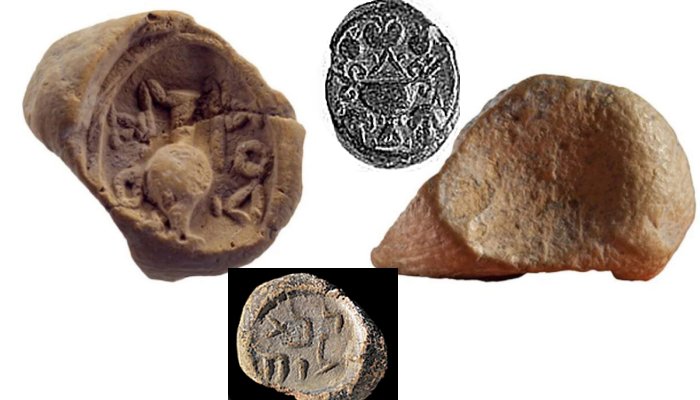Conny Waters - AncientPages.com - The discovery of this captivating miniature clay token has remained unpublished for over a decade since its unearthing by the Temple Mount Sifting Project.
The clay token from the Temple Mount depicting a wine jar and bearing the Greek Inscription: ΔΟΥ-ΛΟ[Υ] - (DOULOU). Source
However, it is a significant archaeological find.
The artifact in question depicts a seal imprint depicting a wine jar, complemented by a Greek inscription. Its striking similarity to another token discovered in the vicinity of the Temple Mount, bearing an Aramaic inscription.
There is a possibility that this ancient clay token may have been utilized by pilgrims preparing on a sacred journey to the Temple in Jerusalem during the Passover festival, spanning a period of two thousand years ago to acquire the necessary components for sacrificial rituals. Scholars have hypothesized that these tokens may have been utilized by pilgrims as a means of exchanging offerings during their sacred visits to the holy site.
In September 2011, during the process of sorting pottery fragments gathered from prior siftings at the Temple Mount Sifting Project, archaeologist Gal Zagdon, observed a diminutive, irregularly shaped clay artifact. While the artifact was made while meticulously examining the collected shards, it became evident that the object in question was not a mere potsherd, but rather a diminutive lump of clay bearing a distinct seal impression.
Different from the conventional clay sealings (colloquially referred to as bullae), the reverse side of the artifact exhibited a pinched appearance, indicating its nature as a token intended for manual delivery to the recipient.
This characteristic distinguished it from commonly known sealings typically affixed to secure knots on documents or containers.
This seal impression depicts an amphora, a type of wine jar prevalent in the latter half of the first century CE, approximately a century prior to the destruction of the Second Temple.
A similar shape clay token found in an Israel Antiquities Authority excavation near the southern part of the Western Wall bearing the Aramaic Inscription. source
Six Greek letters are visible encircling the wine jar; however, one of the letters was not well-preserved in the imprint, so its reading is only assumed by the scholars.
The decipherment of the inscription was done by Dr. Leah Di Segni from the Hebrew University of Jerusalem, a distinguished expert in the field of ancient Greek epigraphy.
It revealed the letters ΔΟΥ-ΛΟ[Υ] (DOULOU), representing the genitive form of the personal name - Doulês.
The name was prevalent in the regions of Thrace, Macedonia, and the northern territories bordering the Black Sea, where Jewish communities had established themselves during the latter stages of the Hellenistic era and the early Roman period.
Two months after the unearthing of the Greek token, another remarkably similar token was uncovered during excavations conducted at the drainage channel situated beneath Robinson's Arch, located below the southern expanse of the Western Wall. These excavations were overseen by the esteemed Eli Shukrun and Professor Ronny Reich, from the Israel Antiquities Authority.
Additional clay token from the Jewish Quarter excavations directed by Nachman Avigad. Found in 1970. Photo: Tal Rogovski.
This token featured an Aramaic inscription, initially deciphered as "pure to God" by the excavators.
However, a subsequent interpretation by Professor Shlomo Naeh, a renowned Talmudic scholar from the Hebrew University, proposed that the token served a functional purpose for pilgrims visiting the Temple.
Professor Shlomo Naeh suggested that the token was used as a receipt for offerings, with the inscribed abbreviations denoting the type of sacrifice, the day, the month, and the name of the presiding priestly division for that particular week.
This measure was likely implemented to safeguard against potential forgeries and ensure the integrity of the ritual proceedings. This interpretation was criticized and suggested alternative meanings for the token.
The Aramaic token depicts a wine jar, aligning with the Mishnaic text that discusses nesachim, a term for the wine libation poured on the Temple altar, which is also used to refer generally to all the offering components.
A plausible hypothesis that this token was designed for the purpose of accommodating Greek-speaking pilgrims, potentially encompassing members of the Jewish diaspora. Of notable significance, the Mishna corroborates the presence of Greek inscriptions within the confines of the Temple, as evidenced by a passage in another chapter of Tractate Shekalim (3:2), which documents that baskets situated in the treasury chamber bore markings in the Greek alphabet.
In research conducted for the Hebrew University Institute of Archaeology, Dr. Yoav Farhi examined several clay tokens found in Jerusalem. Among them, the two mentioned above, and another token from the Temple Mount Sifting Project with a poorly preserved impression and another found in 1970 during the Jewish Quarter excavations by Prof. Nachman Avigad.
The latter bore a seal impression depicting a chalice symbol also appearing on shekel coins from the last days of the Second Temple period, typically interpreted as one of the Temple vessels. The discovery of clay sealings dating back to the Early Roman period, encompassing the final two centuries of the Second Temple era, is a rare find in Israel. The unearthing of clay tokens bearing a pinched reverse side is an unprecedented find, as no other archaeological sites have yielded such artifacts.
All four tokens were found in the proximity of the Temple Mount, and were likely associated in some way with the activities that took place in the Temple.
Their style is completely different from that of other known tokens from the Roman world.
Who used these tokens, and who issued them? How were they used? What is the significance of the wine jar symbol on the Greek inscribed token?
Another interesting question is: Who was Doulês? Is the last letter in this name really an Upsilon?
Could there also be other possible readings of this inscription?
Written by Conny Waters - AncientPages.com Staff Writer
